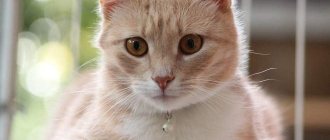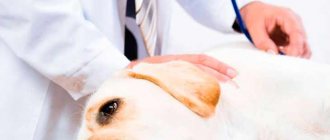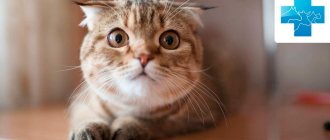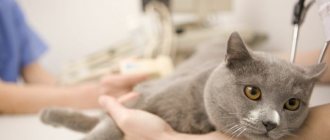One of the most dangerous types of complications in the animal and human body is pulmonary edema. This pathology is characterized by the accumulation of an excessive amount of specific fluid in the lung area, compressing the structural units of the lungs (alveoli) and provoking hypoxia with subsequent degenerative changes.
By its nature, the pathology is unusually dangerous, threatening the life of the cat. Hypoxia, which appears with swelling of the pulmonary structures, causes shortness of breath, myocardial failure and asphyxia.
The cause of edema is ailments of the pulmonary structures, all kinds of infectious diseases, pathologies of the heart and blood vessels. All cats can develop edema, but the risk group includes small kittens and older animals, as well as cats after surgery and pets with weakened immune systems.
The appearance of characteristic signs of pulmonary edema requires the immediate intervention of a qualified specialist, without whose help the pet will quickly die.
Description
The structure of a cat's lungs resembles a bunch of grapes, only the alveoli act as a bunch.
They absorb oxygen inhaled by the cat, and when they exhale they release processed carbon dioxide. This natural process can be disrupted due to damage to the blood vessels or due to their increased permeability. All this can also be contributed to by various diseases and external factors. The capillaries of the alveoli become overfilled with blood fluid, which finds no outlet and accumulates in the alveoli. It interferes with normal gas exchange, resulting in hypoxia (oxygen starvation). In addition to the alveoli, fluid can accumulate in the connective tissues of the lungs (interstitium).
It should be noted that pulmonary edema in cats develops very rapidly. First of all, damage occurs to the brain and central nervous system. To prevent or treat the disease, it is important to know the causes of pulmonary edema.
What is pulmonary edema
The lungs consist of two paired organs and inside have a large number of alveoli (cells). The process of breathing in animals, as in humans, occurs with the participation of alveoli - peculiar bubble formations in the lungs, intertwined with a network of blood vessels. Under normal conditions, the alveoli of the lungs during inhalation are filled with oxygen entering the blood, which then carries it to the brain, nourishes the heart and tissues. When you exhale, exhaust air containing carbon dioxide is released through the alveoli.
In pulmonary insufficiency (edema), for various reasons, transudate (edematous fluid) and the liquid part of the blood enter the alveoli - infiltration. A sharp decrease in the working volume of the lungs disrupts the breathing process and leads to progressive oxygen starvation of the body.
Symptoms
Lethargy, inactivity and lack of appetite in a cat are the first warning signs of pulmonary edema. These harmless signs are characteristic of many diseases, so owners do not immediately begin to sound the alarm. The owner needs to carefully monitor the pet’s behavior, mood and appetite. But the animal does not eat or move, because it has suddenly lost its breath and cannot breathe freely. The mouth opens slightly in an attempt to swallow more air, the tongue hangs lifelessly, and the gaze becomes lost and meaningless.
If suddenly these few signs did not help to detect the cat’s illness, then the following signs should definitely alert the owners. Suddenly wheezing or gurgling appears, the cat begins to breathe convulsively with an open mouth like a dog and walk restlessly. She may have a wet cough with bloody mucus or foam. The cat can lie on its belly with its paws spread wide, and then simply assume a side position. Body temperature may drop sharply, this can be determined by cold extremities. The cat's belly begins to shake, trembling occurs in the area of the withers, and the heartbeat quickens.
Not all symptoms may occur at the same time. Often one is replaced by another, which makes it difficult to make a prompt diagnosis. Symptoms may appear in waves or occur rapidly, bringing the cat closer to death. The cat must be urgently hospitalized.
Predisposition to disease
Pulmonary edema of a cardiogenic nature more often occurs in cats of certain breeds that have a hereditary tendency to cardiovascular pathologies. This breed defect is inherent in many artificially bred cat breeds:
- sphinxes;
- Maine Coon;
- the British;
- Scottish Fold;
- Persian and representatives of other breeds.
Kittens more often suffer from traumatic pulmonary edema. The pathology develops in them after chest injuries, to which they are very susceptible.
There is no difference in the incidence of this pathology between males and females.
Treatment
In the event of a sudden development of symptoms of pulmonary edema, many may try to relieve them on their own. To do this, he needs to administer Furosemide or Lasix, which have a diuretic effect (dosage 0.1 ml per 1 kg).
Before administering the drug, be sure to consult a veterinarian. For kidney disease, use diuretics with caution. It is advisable to film a cat’s attack on your phone camera and send the video to the doctor for a clearer understanding of the picture.
If there is fear and doubt, then it is better to refrain from independent actions. Do not delude yourself that one injection is enough for recovery. The cat must be taken to a veterinary clinic immediately. The main thing is that the cat owner should not panic. Fear and panic can be transmitted to the cat and worsen its condition. We must try to isolate the animal from external noise influences and transport it in a lateral position. If he starts to be stubborn and tries to sit down or stand up, don’t put pressure on him. The animal itself will choose a comfortable position in the carrier.
To relieve acute symptoms, the veterinarian supplies the cat with oxygen through a mask or performs artificial ventilation. Then a general and biochemical blood test is performed, urine is collected, and an x-ray is taken to identify the causes of pulmonary edema in the cat. To identify a cardiogenic or non-cardiogenic factor in the origin of pulmonary edema, an ECG and ultrasound of the heart are prescribed.
Once the diagnosis is confirmed, the cat is given potent diuretics to remove fluid and sedatives are prescribed to restore the nervous system. In the most severe cases, a tracheotomy or thoracentesis has to be done. After all the procedures, the cat is placed in a hospital, preferably a separate one, under the 24-hour supervision of doctors. For quick recovery, droppers with vitamin complexes are prescribed.
When returning home, the cat must be given additional care during the rehabilitation period. It is necessary to follow all recommendations of the veterinarian. Cats with cardiogenic factor require a lifelong course of medication.
It happens that a cat cannot be saved if a relapse occurs. Owners must be prepared for this.
You cannot perform artificial respiration on your own and try to pump out the fluid. You may lose time and not have time to save the animal. Sometimes the minutes count.
Diagnostic methods
If you suspect fluid accumulation in your pet's lungs, you should immediately contact a veterinarian and do not self-medicate or let the situation take its course.
Diagnosis of pulmonary edema requires an integrated approach, which includes the following measures:
- Chest X-ray.
- Echocardiography - ultrasound of the heart.
- Listening with a stethoscope.
- Analysis of urine.
- General blood analysis.
- Blood test for biochemistry.
The test results are processed by a specialist to determine the root cause of the swelling.
Important! The diagnosis of pulmonary edema cannot be made solely on the basis of anamnesis and examination of the pet - remember this when choosing a clinic and attending physician.
Prevention
You can prevent death from pulmonary edema in a cat if you follow a few simple rules:
- Regularly undergo preventive examinations with mandatory vaccinations.
- Prevent the risk of allergic reactions.
- When purchasing food, be guided not by price, but by quality.
- Do not restrict the cat's movements. The more she runs and plays, the better for her health.
- Avoid contact with electricity and toxic substances.
- Avoid hypothermia and overheating.
- Do not let the animal go outside.
The main rule is simple - constant monitoring of the cat’s condition. This is especially true for owners of purebred cats. You need to pay more attention to your pets, and they will be healthy and happy.
Consequently, pulmonary edema in cats can be treated provided that the animal is constantly monitored and timely contact a specialist if the slightest signs of the disease are detected. Relapses occur mainly in cats with heart disease or due to age. You should carefully monitor your pets to prevent recurrence of the disease. You can keep a health diary (video diary) and record all observations and changes in it.
Causes
Pulmonary edema in cats develops as a result of various causes. But it is worth remembering that this pathology is not a disease. Pulmonary edema is a serious symptom and type of complication that occurs against the background of an underlying illness.
Pulmonary edema in cats is divided into two main types:
- cardiogenic pulmonary edema in cats;
- swelling not associated with diseases of the cardiovascular system.
Cardiogenic
Very often, the cause of pulmonary edema in cats lies in heart disease. Some destructive processes in the heart and blood vessels lead to a deterioration in the flow of blood and lymph, as a result of which fluids stagnate and begin to fill the lungs.
Lung tissue itself is very porous, and it is full of cells, which is why this organ suffers in the first place. Cardiogenic pulmonary edema in cats is characterized by a gradual filling of the alveoli with fluid, an increase in oxygen starvation of tissues, turning into asphyxia. In this case, in order to save the animal, resuscitation measures cannot be avoided.
Cardiogenic pulmonary edema in a cat occurs when:
- Hypertrophic cardiomyopathy.
- Chronic heart valve diseases.
- Heart defect.
- Heart failure.
- Arterial hypertension.
- Cardiosclerosis.
- Pulmonary embolism.
Heart disease can be congenital or acquired. Cats of artificially bred breeds suffer from similar ailments more often.
Non-cardiogenic
The cause of pulmonary edema can also lie in injuries, disorders in the body, infectious diseases, and others:
- Allergic reactions (including to anesthesia).
- Aspiration pneumonia.
- Injuries to internal organs as a result of falls from height.
- Electric shock.
- Choking (carbon smoke poisoning).
- Anemia.
- Heatstroke.
- Lung cancer.
- Laryngeal paralysis.
- Head injuries: bruise and concussion.
- Severe stress.
- Injuries to internal organs during sterilization/castration operations.
- Poisoning with poisons and chemicals.
- Bacterial blood infections.
- Pancreatitis.
- Prolonged seizures (epilepsy).
- Poisonous snake bites.
- Uremia is intoxication resulting from renal failure.
- Anorexia.
- Sepsis.
- Aspiration is the entry of vomit into the respiratory tract.
Many owners who love to overfeed their pets are unaware that obesity leads to heart disease. This, in turn, entails other problems, including swelling of the organs.
Varieties
Cardiogenic and non-cardiogenic
The symptom may occur in a pet during an allergy.
Depending on the origin, a cardiogenic type is distinguished, which includes all cases associated with disruption of the cardiac system. The main symptom is considered to be high blood pressure. There is also a second group, which includes root causes that are not directly related to the functioning of the heart, for example, non-cardiogenic edema. The source is an allergy, tumor or inflammation. Edema requires urgent treatment.
Another typology
There is also a classification based on the speed of development, which is presented in the table:
| View | Description |
| Fulminant | Rapid development that can be fatal |
| Spicy | Signs appear within a few hours |
| Subacute | Wave-like development with declines and intensification of pathology |
| Protracted | Does not appear immediately, looks like a chronic disease |
First aid before going to the veterinary clinic
If there are signs of pulmonary edema, immediate assistance to the animal is very important, since it determines whether resuscitation will be successful. Before delivering the cat to the clinic, it is necessary to make the breathing process as easy as possible for her using improvised methods:
- give an injection of a diuretic (Furosemide);
- open the windows or take the cat out into the fresh air;
- provide the animal with complete rest and limit physical activity;
- do not disturb or take any forceful action towards him;
- deliver to the clinic as quickly as possible;
- During transportation, it is advisable to place the animal on its side.
If first aid is provided correctly, then subject to a professional approach to the choice of treatment method, there is hope that the animal will recover.
What are the dangers of self-medication of pulmonary edema?
Some people are interested in whether it is possible to cure pulmonary edema in a cat on your own? Under no circumstances should you do this. Firstly, special medications and injections are required to quickly relieve swelling and replenish oxygen in the animal’s body. Secondly, as mentioned above, edema is not an independent disease, but only a consequence of another pathology. And it’s not enough just to eliminate the swelling, you need to find the cause and try to cure it.
At home, a cat can be given first aid, but it is still necessary to take it to a specialist for examination. Even if you manage to remove fluid from the cat’s respiratory system on your own and relieve pulmonary edema, a relapse risks reoccurring with even more serious consequences.











